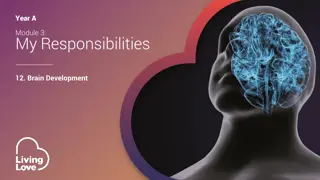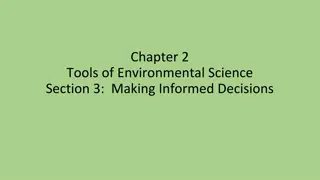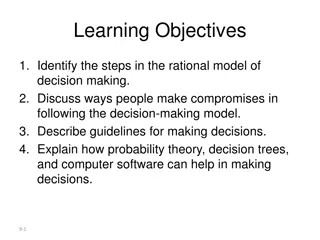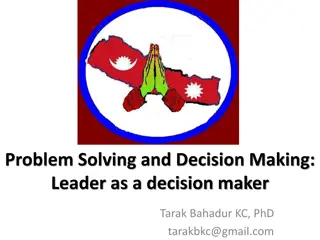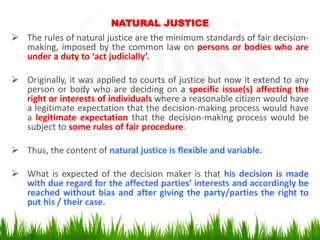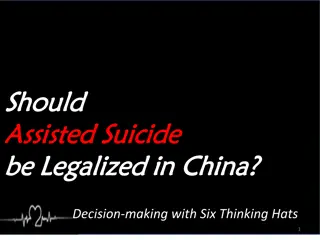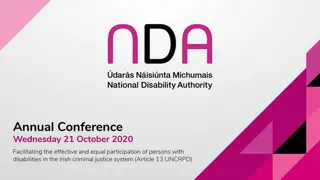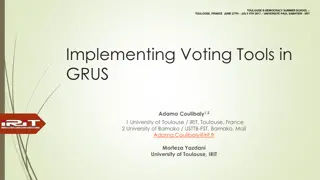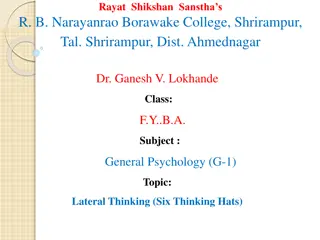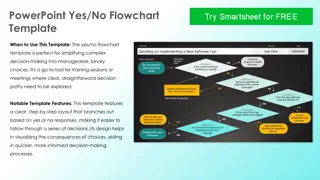DECISION MAKING
In the world of business, leadership and management play crucial roles in guiding organizations towards success. Explore the six facets of leadership and management, understand the differences between managers and leaders, and discover the influence of gifting on decision-making. Learn how to balance the natural tensions between leaders and managers to achieve optimal results. Gain insights into effective decision-making strategies presented by Luceille Outhred at ICI Philippines in 2013.
Download Presentation

Please find below an Image/Link to download the presentation.
The content on the website is provided AS IS for your information and personal use only. It may not be sold, licensed, or shared on other websites without obtaining consent from the author.If you encounter any issues during the download, it is possible that the publisher has removed the file from their server.
You are allowed to download the files provided on this website for personal or commercial use, subject to the condition that they are used lawfully. All files are the property of their respective owners.
The content on the website is provided AS IS for your information and personal use only. It may not be sold, licensed, or shared on other websites without obtaining consent from the author.
E N D
Presentation Transcript
DECISION MAKING Presented by Luceille Outhred ICI Philippines 2013
6 Facets of Leadership and Management Management Commitment Strategic Plan Compentency Performance Profiles Team Plan Monitor, Evaluate and Review Procedures Preparation for Implementation
Management and Leadership Two Wings One Bird
Management ... involves overseeing and guidance. It implies the exercise either of personal or of delegated authority.
Manager A manager is one who supervises an operation or an organisation, and who is capable of assigning, directing and inspecting work done
Leadership ... Involves directing the organisation, knowing where it is going and being able to persuade others to come along. Often perceived as a guiding force, and an influencer
Leader A leader directs and is voluntarily followed because of an ability to guide and control others. The one who is leading MAY not be the appointed leader!
The Influence of Gifting on Decision Making MANAGER Seeks Stability LEADER Thrives in Chaos Use Authority Seeks to Influence Instruct Inspire Practical Visionary Calculating Charismatic
The Influence of Gifting on Decision Making MANAGER Analytical LEADER Visionary Structured Passionate Decisive Flexible Controlled Uncontrolled Deliberate Unstructured Orderly Creative
Remember: Proverbs 14:4 Where there are no oxen, the manger is clean, but from the strength of an ox come abundant harvests.
Natural Tensions Between Leaders and Managers Natural Tension 1: Managers focus on the bottom-line; Leaders focus on the top-line.
Natural Tensions Between Leaders and Managers Natural Tension 2: Managers consider dangers; Leaders sense opportunities.
Natural Tensions Between Leaders and Managers Natural Tension 3: Managers follow Versions; Leaders pursue Visions.
Natural Tensions Between Leaders and Managers Natural Tension 4: Managers Isolate; Leaders Correlate.
Natural Tensions Between Leaders and Managers Natural Tension 5: Managers search for solutions; Leaders identify problems.
Natural Tensions Between Leaders and Managers Natural Tension 6: Managers think rivals; Leaders seek partners.
Natural Tensions Between Leaders and Managers Natural Tension 7: Managers plan step-by-step tactics; Leaders lay out sweeping strategic plans.
Natural Tensions Between Leaders and Managers Natural Tension 8: Managers correct tactical weaknesses; Leaders build on strategic strengths.
Natural Tensions Between Leaders and Managers Natural Tension 9: Managers exercise authority; Leaders apply influence.
Natural Tensions Between Leaders and Managers Natural Tension 10: Managers seek uniformity; Leaders pursue unity.
Natural Tensions Between Leaders and Managers Natural Tension 11: Managers administer programs and policies; Leaders set examples and watch people.
Natural Tensions Between Leaders and Managers Natural Tension 12: Managers instruct; Leaders inspire.
Make Disciples, not Clones Managers should strive to nurture leaders as well as managers. Leaders should strive to nurture managers as well as leaders.
Managers Mentoring Leaders A good manager who nurtures leaders will be like one who takes eagles and teaches them to fly in formation.
6 Corporate Facets Inter- Interaction departmental Interconnection relationships Inter- Interception Interdependence
My Problem Solving and Decision Making Style Tool 1 When I am working with other people I would describe myself as: Predictable Conformist 1 1 2 2 3 3 4 4 5 5 6 6 6 6 6 6 6 Surprising Opportunist Policy maker Agreeable Considerate Serious Loyal 1 1 1 1 1 2 2 2 2 2 3 3 3 3 3 4 4 4 4 4 5 5 5 5 5 Rule breaker Disagreeable Risk-taker Flexible Independent
My Problem Solving and Decision Making Style Tool 1 Adaptor Mediator Novelist
Considering 7 Others in my Organisation Tool 2 Initiators Deciders Conceptualisers Facilitators Developers Implementers Other Affected Stakeholders
How People Respond to Change Experimenters how is it new? Opportunists can I be involved? Pragmatists What will it cost? Skeptics What does everyone else think? Antagonists Why should I comply?
Made in the Image of God We are all creators, made in the image of the Creator We adopt change that we perceive as relevant People s pace of adoption varies
Z Problem Solving Model Based on Myers Briggs Temperament Types Sensing (Facts) Intuition (Possibilities) Thinking (Consequences) (How will this impact on People) Feeling Extraversion to communicate the solution Intraversion to reflect and review
Brainstorming Tool 3 The Problem, The Process, The People, The Pantry A great tool for solving identified problems A good man draws out of his store.... Hurt people hurt people.... Brainstorm .... 100 Uses of a house brick...
Problem Solving and Decision Making 1. State or define the problem 2. Brainstorm possible causes 3. Agree on and select most appropriate solution (using agreed criteria) 4. Action plan for implementing solution 5. Evaluate the outcome
Integrated Steps to Problem Solving 1. Problem Awareness 2. Data Gathering 3. Problem Definition 4. Goal Statement 5. Identifying the measurable outcome 6. Solutions generation 7. Solution selection 8. Ongoing Evaluation
Exercising Good Judgment Judgment is what you do, when you don t (and can t) know what you should do, but you know you have to do something quickly - so you do it. Judgment can only come about as a result of the efficient working of a good intellect.
EMPOWERMENT AND DELEGATION Presented by Luceille Outhred ICI Asia 2013
Leading A good leader can get great results from average people Leading is causing people to take effective action. An effective leader enables followers to see the cathedral, while mixing cement!
Functions of Leadership To initiate change To provide stability in change Change is necessary where there is growth.
Four Leadership Styles Directive Consultative Collaborative Delegation
Delegation Delegation is the partnership of authority and responsibility with another person. Delegator retains accountability, but delegates responsibility of carrying out tasks
Delegation Is appropriate when: a. other people can be trusted to perform the task well b. task can be done cheaper and better by delegation c. task gives workers the chance to develop new skills and experience
Benefits of Delegation Cost saving Time saving Skills building People motivation Successor grooming
Effective Delegation is Essential Acts 6:3 Management Organisational growth Leadership succession People development
Delegated Goals are SMARTER See Tool 4 S pecific M easurable A greed R ealistic T imebound E thical R ecorded
Empowerment Empowerment means to give or delegate power or authority to. Is an ongoing process NOT an outcome
Values Core and Shared Core Values are immutable, they never change Shared Values tribal, family, organisational hierarchy, social structures, community ideals DNA Culture Rachel Eliot & Aucas OUT of every tribe, kindred, nation ... Why? My Core Values Benefits of a Team Culture
RECAP: Functions of Leadership To initiate change To provide stability in change
From Current Realities to Vision Fulfilled Change is a transitional process that moves the organisation from its current state to its desired state Change Current State Desired State Where we want to be Where we are now
Implementing Change - 5 Essential Steps 1. Clarify the Scope of the Vision 2. List and Prioritise all the Actions 3. Draft a Preliminary Plan 4. Review and Finalise the Plan 5. Revise the Plan as you go
Role Categories Task Roles: are directed to the work being done by team members. Maintenance Roles: are directed at improving and sustaining constructive relationships in the team.







